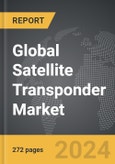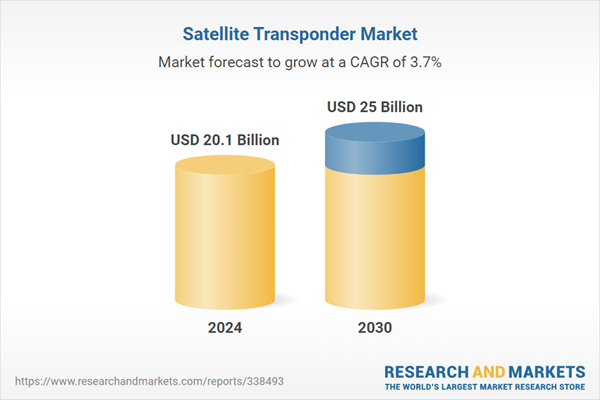The global market for Satellite Transponder was valued at US$20.1 Billion in 2024 and is projected to reach US$25.0 Billion by 2030, growing at a CAGR of 3.7% from 2024 to 2030. This comprehensive report provides an in-depth analysis of market trends, drivers, and forecasts, helping you make informed business decisions. The report includes the most recent global tariff developments and how they impact the Satellite Transponder market.
Segments: Application (Broadcast, Trunking, Reserve, Networking).
Geographic Regions/Countries: World; United States; Canada; Japan; China; Europe (France; Germany; Italy; United Kingdom; and Rest of Europe); Asia-Pacific; Rest of World.
The analysts continuously track trade developments worldwide, drawing insights from leading global economists and over 200 industry and policy institutions, including think tanks, trade organizations, and national economic advisory bodies. This intelligence is integrated into forecasting models to provide timely, data-driven analysis of emerging risks and opportunities.
Global Satellite Transponder Market - Key Trends and Drivers Summarized
What Exactly Are Satellite Transponders and How Do They Work?
Satellite transponders are vital components in the field of satellite communications, acting as the heart of satellite functionality. A transponder receives signals from the Earth, amplifies them, changes their frequency to avoid interference with incoming signals, and then retransmits them back to Earth. This two-way process involves uplink frequencies (Earth to satellite) and downlink frequencies (satellite to Earth), ensuring seamless communication over vast distances. Typically, each satellite houses multiple transponders, each dedicated to a specific bandwidth and service, such as television broadcasting, internet connectivity, and telecommunication services. The importance of transponders lies in their ability to handle high data rates, support various types of data transmission, and maintain the integrity of the signal despite the vast distances it travels.How Have Technological Advancements Shaped Satellite Transponders?
Technological advancements have significantly enhanced the efficiency and capabilities of satellite transponders. The shift from analog to digital transponders marked a revolutionary change, enabling more data to be transmitted with higher quality and reduced noise. Innovations such as High Throughput Satellites (HTS) and the deployment of Low Earth Orbit (LEO) satellite constellations have further expanded the potential of satellite transponders. HTS use spot beam technology to provide high data rates and better coverage, making them ideal for internet services and data-intensive applications. Meanwhile, LEO satellites, positioned closer to Earth, reduce latency and improve the speed of data transmission. These advancements have not only improved the performance of transponders but also opened new avenues for their application in various sectors, including disaster management, military communication, and remote sensing.What Are the Key Challenges and Solutions in Satellite Transponder Utilization?
Despite their critical role, satellite transponders face several challenges that need addressing to maximize their effectiveness. One primary issue is the limited availability of frequency spectrum, which is becoming increasingly congested due to the growing demand for satellite services. This scarcity necessitates efficient spectrum management and the development of technologies that can operate in higher frequency bands, such as the Ka and Ku bands. Another challenge is the susceptibility of satellite signals to interference from both terrestrial and space-based sources. Advanced modulation and coding techniques, alongside robust signal processing algorithms, are being developed to mitigate these interferences and enhance signal reliability. Additionally, the cost of launching and maintaining satellites remains high, prompting the exploration of cost-effective launch vehicles and reusable satellite components. These solutions are essential to ensure the sustainable growth and functionality of satellite transponders.What Drives the Growth in the Satellite Transponder Market?
The growth in the satellite transponder market is driven by several factors directly tied to technological advancements, end-uses, and consumer behavior. Firstly, the increasing demand for high-definition television and the rise of Over-The-Top (OTT) media services require more transponder capacity to deliver high-quality content globally. Secondly, the proliferation of internet usage and the need for broadband connectivity in remote and underserved areas are pushing the demand for satellite-based internet services. This is particularly crucial in regions where terrestrial infrastructure is lacking or infeasible. Thirdly, the expansion of the Internet of Things (IoT) and Machine-to-Machine (M2M) communications necessitates reliable and widespread satellite communication networks. Moreover, the defense and military sectors continue to rely heavily on satellite transponders for secure and resilient communication channels. Lastly, the commercialization of space and the increasing number of private players entering the satellite industry are fostering innovation and reducing costs, further propelling market growth. These factors collectively underscore the dynamic and evolving nature of the satellite transponder market, driving its expansion and adoption across various domains.Report Scope
The report analyzes the Satellite Transponder market, presented in terms of units. The analysis covers the key segments and geographic regions outlined below.Segments: Application (Broadcast, Trunking, Reserve, Networking).
Geographic Regions/Countries: World; United States; Canada; Japan; China; Europe (France; Germany; Italy; United Kingdom; and Rest of Europe); Asia-Pacific; Rest of World.
Key Insights:
- Market Growth: Understand the significant growth trajectory of the Broadcast Application segment, which is expected to reach US$12.0 Billion by 2030 with a CAGR of a 3.9%. The Trunking Application segment is also set to grow at 4.2% CAGR over the analysis period.
- Regional Analysis: Gain insights into the U.S. market, valued at $5.4 Billion in 2024, and China, forecasted to grow at an impressive 3.5% CAGR to reach $4.0 Billion by 2030. Discover growth trends in other key regions, including Japan, Canada, Germany, and the Asia-Pacific.
Why You Should Buy This Report:
- Detailed Market Analysis: Access a thorough analysis of the Global Satellite Transponder Market, covering all major geographic regions and market segments.
- Competitive Insights: Get an overview of the competitive landscape, including the market presence of major players across different geographies.
- Future Trends and Drivers: Understand the key trends and drivers shaping the future of the Global Satellite Transponder Market.
- Actionable Insights: Benefit from actionable insights that can help you identify new revenue opportunities and make strategic business decisions.
Key Questions Answered:
- How is the Global Satellite Transponder Market expected to evolve by 2030?
- What are the main drivers and restraints affecting the market?
- Which market segments will grow the most over the forecast period?
- How will market shares for different regions and segments change by 2030?
- Who are the leading players in the market, and what are their prospects?
Report Features:
- Comprehensive Market Data: Independent analysis of annual sales and market forecasts in US$ Million from 2024 to 2030.
- In-Depth Regional Analysis: Detailed insights into key markets, including the U.S., China, Japan, Canada, Europe, Asia-Pacific, Latin America, Middle East, and Africa.
- Company Profiles: Coverage of players such as APT Satellite Company Ltd., Arab Satellite Communication Organization, Eutelsat, Intelsat SA, NEC Corporation and more.
- Complimentary Updates: Receive free report updates for one year to keep you informed of the latest market developments.
Some of the 39 companies featured in this Satellite Transponder market report include:
- APT Satellite Company Ltd.
- Arab Satellite Communication Organization
- Eutelsat
- Intelsat SA
- NEC Corporation
- Northrop Grumman Corp.
- Russian Satellite Communications Company
- SES S.A.
- Telesat
- Thales Alenia Space
- XTAR
Tariff Impact Analysis: Key Insights for 2025
Global tariff negotiations across 180+ countries are reshaping supply chains, costs, and competitiveness. This report reflects the latest developments as of April 2025 and incorporates forward-looking insights into the market outlook.The analysts continuously track trade developments worldwide, drawing insights from leading global economists and over 200 industry and policy institutions, including think tanks, trade organizations, and national economic advisory bodies. This intelligence is integrated into forecasting models to provide timely, data-driven analysis of emerging risks and opportunities.
What’s Included in This Edition:
- Tariff-adjusted market forecasts by region and segment
- Analysis of cost and supply chain implications by sourcing and trade exposure
- Strategic insights into geographic shifts
Buyers receive a free July 2025 update with:
- Finalized tariff impacts and new trade agreement effects
- Updated projections reflecting global sourcing and cost shifts
- Expanded country-specific coverage across the industry
Table of Contents
I. METHODOLOGYII. EXECUTIVE SUMMARY2. FOCUS ON SELECT PLAYERSIII. MARKET ANALYSISIV. COMPETITION
1. MARKET OVERVIEW
3. MARKET TRENDS & DRIVERS
4. GLOBAL MARKET PERSPECTIVE
UNITED STATES
CANADA
JAPAN
CHINA
EUROPE
FRANCE
GERMANY
ITALY
UNITED KINGDOM
REST OF EUROPE
ASIA-PACIFIC
REST OF WORLD
Companies Mentioned (Partial List)
A selection of companies mentioned in this report includes, but is not limited to:
- APT Satellite Company Ltd.
- Arab Satellite Communication Organization
- Eutelsat
- Intelsat SA
- NEC Corporation
- Northrop Grumman Corp.
- Russian Satellite Communications Company
- SES S.A.
- Telesat
- Thales Alenia Space
- XTAR
Table Information
| Report Attribute | Details |
|---|---|
| No. of Pages | 272 |
| Published | April 2025 |
| Forecast Period | 2024 - 2030 |
| Estimated Market Value ( USD | $ 20.1 Billion |
| Forecasted Market Value ( USD | $ 25 Billion |
| Compound Annual Growth Rate | 3.7% |
| Regions Covered | Global |









